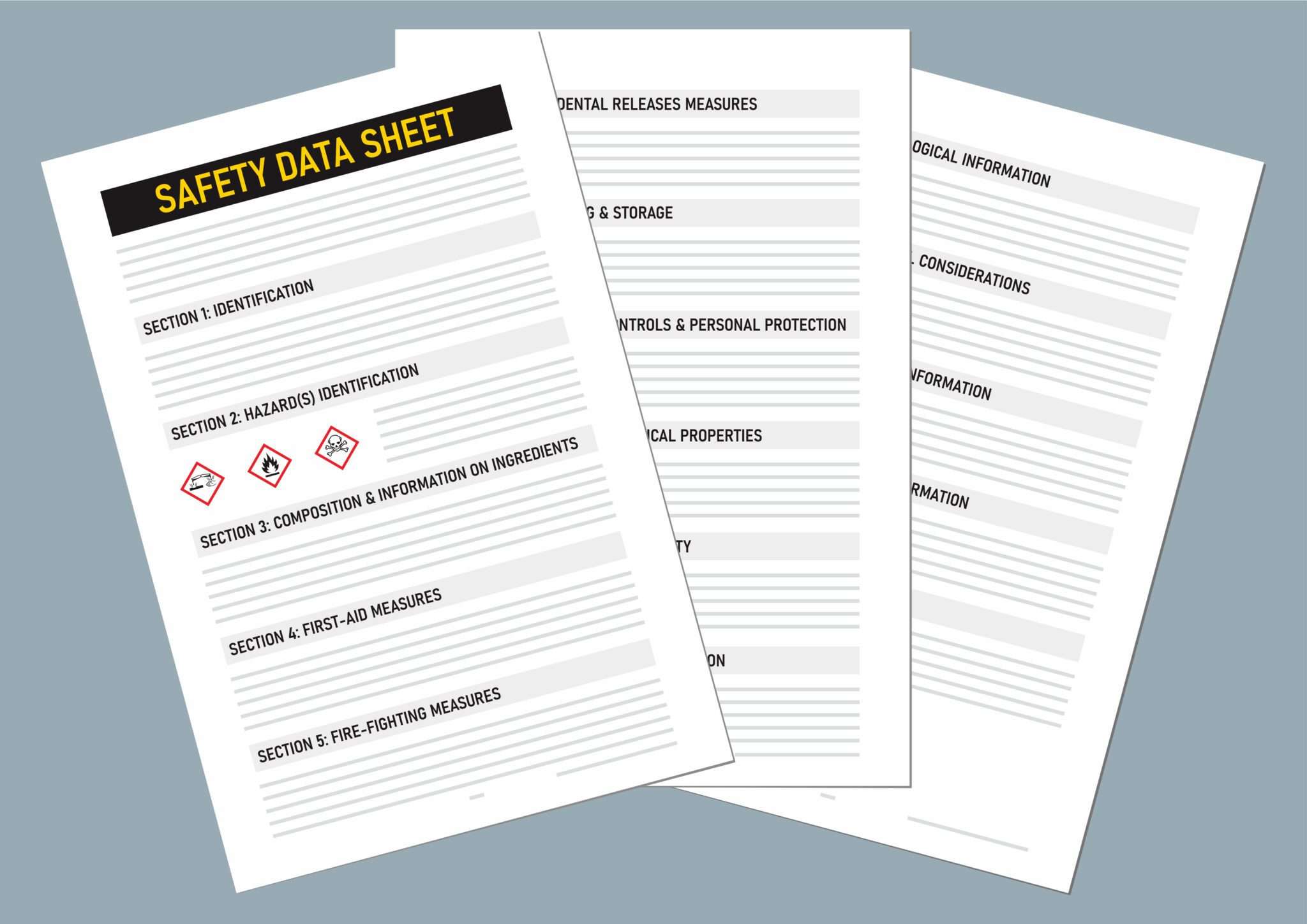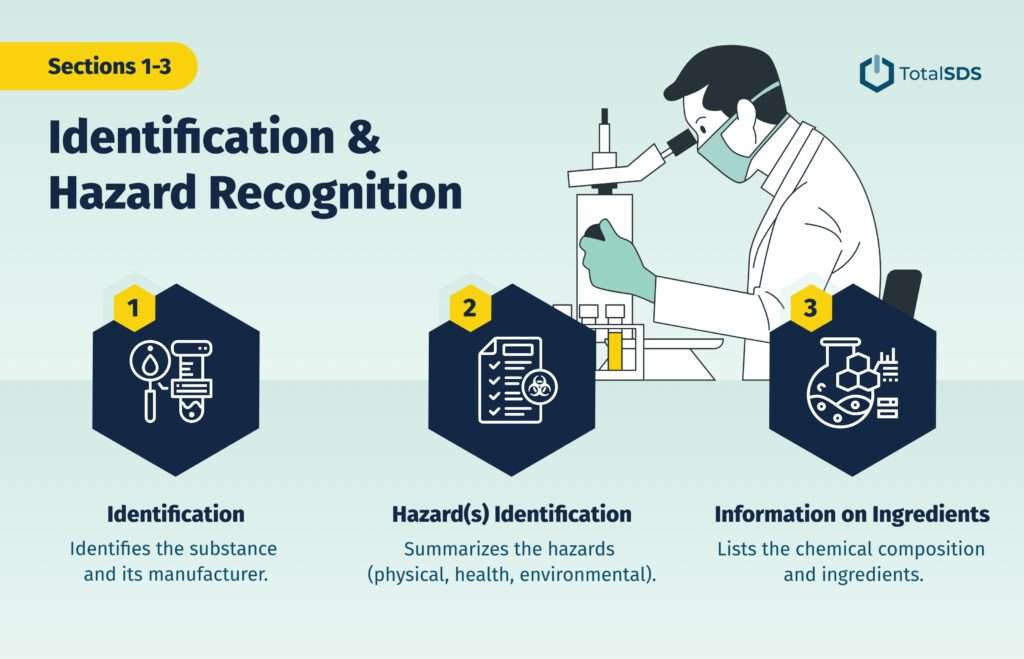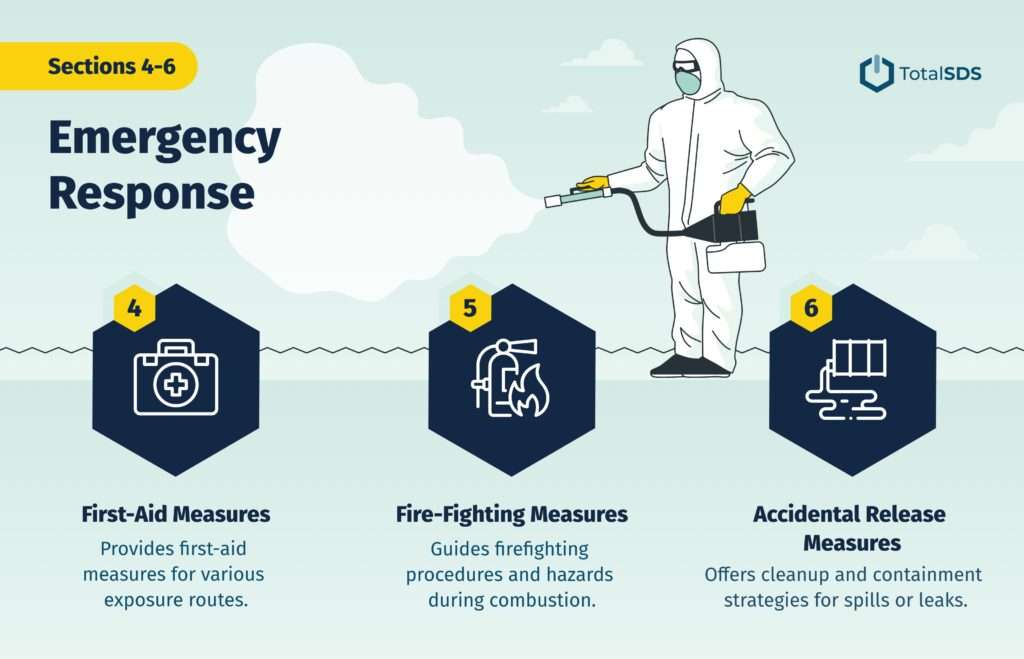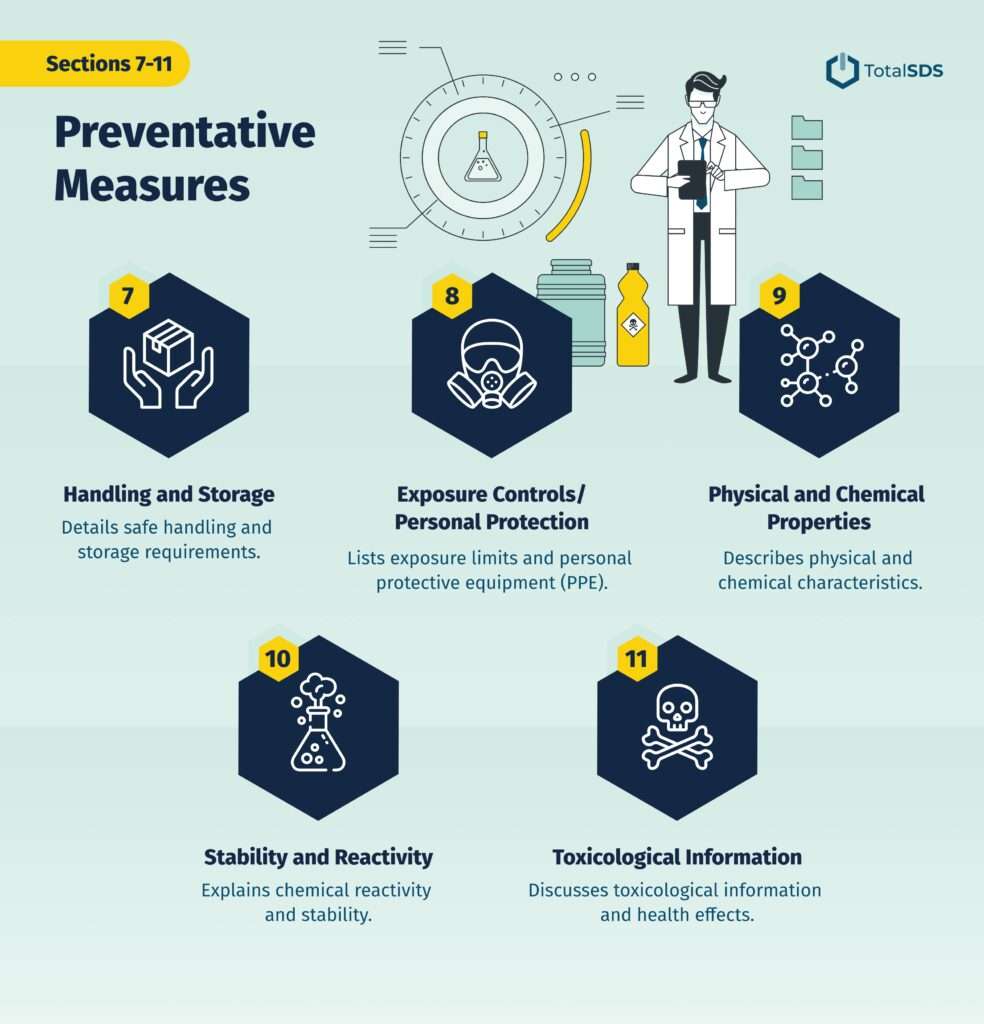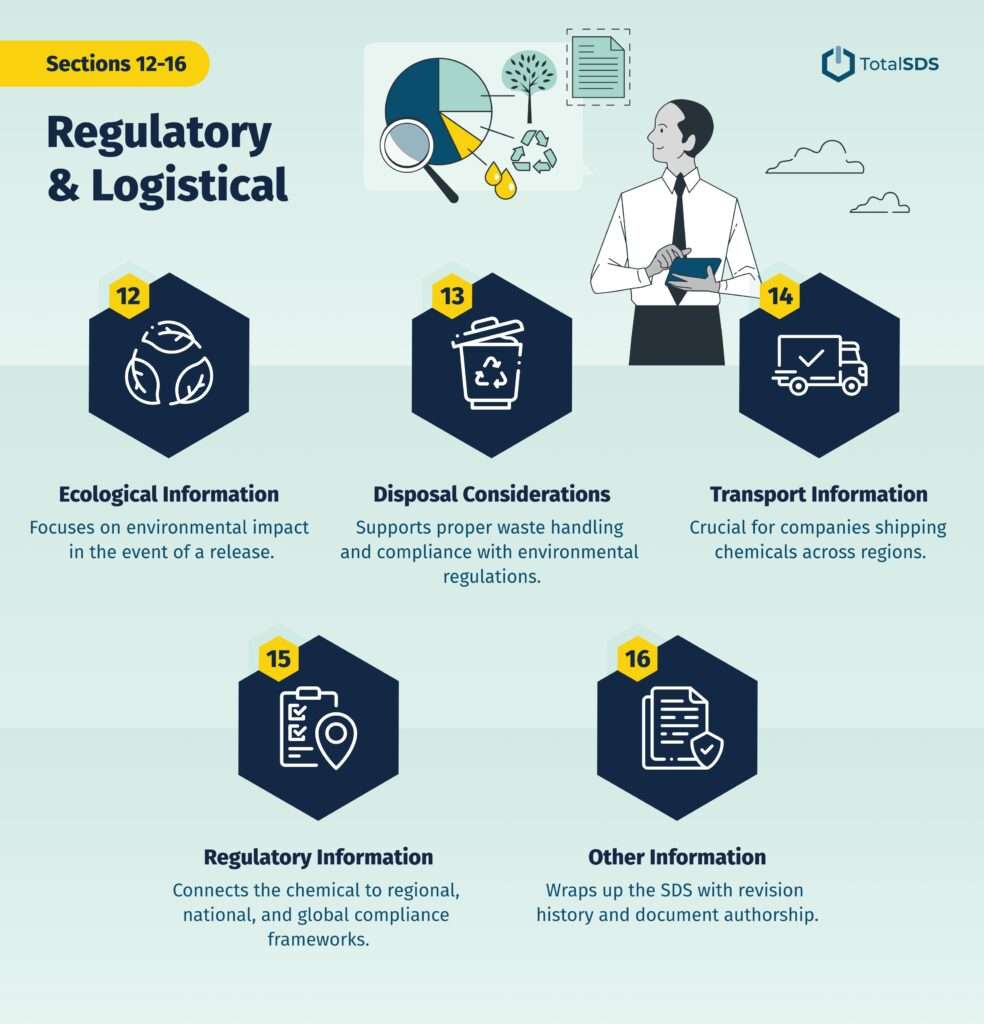In any industry where chemicals are used, stored, or transported, understanding and managing hazards isn’t just good practice — it’s a regulatory necessity. At the heart of this responsibility lies the Safety Data Sheet (SDS): a critical document that serves as the foundation for hazard communication, risk assessment, emergency response, and regulatory compliance.
More than just paperwork, SDSs are comprehensive, standardized guides that provide life-saving information about chemical substances — from their physical properties and health risks to safe handling, storage, and disposal procedures. Whether you’re overseeing a laboratory, manufacturing plant, construction site, or small business, knowing how to read and interpret each part of an SDS is essential to creating a safe and legally compliant workplace.
In this in-depth guide, we’ll walk you through each of the 16 mandatory sections of an SDS, explain how they’re categorized and structured, and answer key questions such as:
- What exactly is an SDS, and why does it matter?
- Can SDSs be managed digitally?
- How can digital SDS solutions improve compliance and efficiency?
Finally, we’ll explore how TotalSDS simplifies SDS authoring and management — helping businesses stay ahead of compliance requirements while dramatically reducing time, effort, and risk.
What Is a Safety Data Sheet?
A Safety Data Sheet (SDS) is a document that provides critical information about the properties, hazards, handling, storage, and emergency procedures related to a chemical substance or mixture. Required by OSHA’s Hazard Communication Standard (HCS) in the United States, SDSs help ensure that employers and employees are informed about chemical hazards in the workplace.
Each SDS is formatted into 16 standardized sections, making it easier for businesses to interpret and respond appropriately to chemical risks.
Can an SDS Be Digital?
Yes — and it should be.
Digital SDSs are not only OSHA-compliant, but they are also far more efficient to manage, search, and update than traditional paper binders. In fact, digitizing your SDS system can drastically improve response times in emergencies, streamline compliance audits, and reduce operational risk.
Curious how digital transformation can impact your workplace? Check out our blog on why moving your SDS to digital is a game-changer for workplace safety.
The 16 Sections of a Safety Data Sheet (SDS), Explained in Detail
Understanding what each section of a Safety Data Sheet includes — and why it matters — is essential for proper chemical management, workplace safety, and regulatory compliance. Here’s a deep dive into each of the 16 mandatory SDS sections as defined by the OSHA Hazard Communication Standard (29 CFR 1910.1200) and aligned with the Globally Harmonized System (GHS):
1. Identification
This section sets the stage for the entire SDS by clearly identifying the chemical and its basic characteristics.
- Purpose: Provides the product’s name, its intended use, and the contact details of the manufacturer or distributor and emergency contact — all of which are critical in the event of an emergency or product question.
- Includes:
- Product name or identifier (matching the container label)
- Relevant uses and restrictions
- Supplier/manufacturer name, address, and phone number
- Emergency contact number for spills, exposure, or fire
2. Hazard(s) Identification
This is one of the most critical sections for understanding the risks associated with a chemical.
- Purpose: Summarizes the physical, health, and environmental hazards in an easy-to-recognize format, helping users quickly determine potential dangers.
- Includes:
- GHS hazard classification (e.g., flammable liquid, skin irritant)
- Signal word (“Danger” or “Warning”)
- Hazard statements (e.g., “Causes severe skin burns and eye damage”)
- Pictograms representing the hazard (e.g., flame, skull and crossbones)
- Precautionary statements for safe use
- Non-GHS hazards adopted by OSHA (e.g., combustible dust)
3. Composition/Information on Ingredients
This section identifies what the substance or mixture is made of.
- Purpose: Lists each ingredient’s identity and concentration, particularly important for mixtures and assessing exposure risk.
- Includes:
- Chemical name and synonyms
- CAS (Chemical Abstracts Service) number
- Percentages or concentration ranges of hazardous ingredients
- Impurities or stabilizers contributing to classification
4. First-Aid Measures
A lifesaving section when exposure or accidents occur.
- Purpose: Provides step-by-step instructions for immediate care following exposure through inhalation, ingestion, or skin/eye contact.
- Includes:
- Symptoms/effects (both acute and delayed)
- Recommended first-aid treatment for each exposure route
- Notes for medical professionals (e.g., special treatment required)
5. Fire-Fighting Measures
Essential for emergency planning and fire response.
- Purpose: Guides emergency personnel on how to safely extinguish fires involving the chemical.
- Includes:
- Suitable extinguishing agents (e.g., foam, dry chemical)
- Specific hazards arising from combustion (e.g., toxic fumes)
- Protective equipment and precautions for firefighters
6. Accidental Release Measures
Designed to protect personnel, property, and the environment during a spill or leak.
- Purpose: Provides procedures for safe containment, cleanup, and decontamination.
- Includes:
- Evacuation guidelines and personal protective measures
- Environmental precautions (e.g., avoid runoff to waterways)
- Spill response procedures and cleanup techniques
7. Handling and Storage
Helps prevent accidents and maintain chemical integrity.
- Purpose: Describes safe handling practices and storage conditions to minimize risk.
- Includes:
- Handling precautions (e.g., avoid contact with incompatible materials)
- Recommended storage temperatures and conditions
- Incompatibilities with other materials or conditions
8. Exposure Controls/Personal Protection
Critical for worker safety planning and regulatory compliance.
- Purpose: Specifies occupational exposure limits and protective measures.
- Includes:
- OSHA, ACGIH, WEEL, and other exposure limits (e.g., PELs, TLVs)
- Required or recommended personal protective equipment (PPE)
- Engineering controls like fume hoods or ventilation systems
9. Physical and Chemical Properties
A technical snapshot of the substance’s behavior and characteristics.
- Purpose: Helps identify the material and anticipate how it may behave under various conditions.
- Includes:
- Physical state, color, and odor
- Boiling/melting point, flash point, vapor pressure
- pH, solubility, viscosity, and flammability
10. Stability and Reactivity
Key for understanding chemical reactions and safe storage.
- Purpose: Details the conditions under which the substance may become unstable or dangerous.
- Includes:
- Reactivity and chemical stability
- Conditions to avoid (e.g., moisture, heat, sparks)
- Incompatible materials and hazardous decomposition products
11. Toxicological Information
Provides health hazard data based on research and testing.
- Purpose: Explains the chemical’s effects on the body, both immediate and long-term.
- Includes:
- Likely exposure routes (inhalation, ingestion, skin, eyes)
- Acute and chronic health effects
- Carcinogenic, mutagenic, or reproductive risks
- Toxicity values (LD50, LC50)
12. Ecological Information
Focuses on environmental impact in the event of a release.
- Purpose: Helps assess risks to ecosystems, water, and wildlife.
- Includes:
- Aquatic toxicity and degradation potential
- Persistence and bioaccumulation potential
- Mobility in soil and water
Note: Content not enforced by OSHA but required to be listed on the SDS for compliance.
13. Disposal Considerations
Supports proper waste handling and compliance with environmental regulations.
- Purpose: Outlines how to safely dispose of the product, residues, or contaminated packaging.
- Includes:
- Waste treatment recommendations
- Precautions for landfill or incineration
- Regulatory waste classifications where applicable (e.g., hazardous waste codes)
Note: Content not enforced by OSHA but required to be listed on the SDS for compliance.
14. Transport Information
Crucial for companies shipping chemicals across regions.
- Purpose: Details classification, labeling, and requirements for shipping.
- Includes:
- UN number and proper shipping name
- Transport hazard class and packing group
- Special precautions or bulk transport requirements
Note: Content not enforced by OSHA but required to be listed on the SDS for compliance.
15. Regulatory Information
Connects the chemical to regional, national, and global compliance frameworks.
- Purpose: Highlights any regulations specific to the product that may not have been covered in earlier sections.
- Includes:
- Inventory status (TSCA, SARA 313, CA Prop 65, etc.)
- Safety and environmental labeling requirements
- Relevant federal/state/local regulations
Note: Content not enforced by OSHA but required to be listed on the SDS for compliance.
16. Other Information
Wraps up the SDS with revision history and document authorship.
- Purpose: Provides context on document preparation and version control.
- Includes:
- Preparation or revision date
- Additional information sources
- Version history or disclaimers
How SDS Sections Are Categorized
While a Safety Data Sheet (SDS) is structured in 16 standardized sections, these can be grouped into four functional categories based on their purpose and use. Understanding these categories helps users — from safety officers and first responders to lab technicians and compliance managers — quickly find the information they need depending on the situation.
1. Identification & Hazard Recognition (Sections 1–3)
This group lays the groundwork by identifying the chemical and outlining its inherent risks. These sections are typically the first stop for users trying to understand what a substance is and whether it presents any immediate hazards.
- Section 1: Identifies the substance and its manufacturer.
- Section 2: Summarizes the hazards (physical, health, environmental).
- Section 3: Lists the chemical composition and ingredients.
These sections are especially useful during product evaluation, inventory intake, or risk assessment planning.
2. Emergency Response (Sections 4–6)
When accidents occur, this group becomes critical. These sections provide the actionable information needed to respond effectively to spills, fires, or human exposure.
- Section 4: Provides first-aid measures for various exposure routes.
- Section 5: Guides firefighting procedures and hazards during combustion.
- Section 6: Offers cleanup and containment strategies for spills or leaks.
First responders, EH&S professionals, and emergency coordinators rely on this group in high-pressure situations to minimize harm.
3. Preventative Measures (Sections 7–11)
Focused on proactive safety, this group helps businesses design safe workflows, train employees, and implement engineering or administrative controls.
- Section 7: Details safe handling and storage requirements.
- Section 8: Lists exposure limits and personal protective equipment (PPE).
- Section 9: Describes physical and chemical characteristics.
- Section 10: Explains chemical reactivity and stability.
- Section 11: Discusses toxicological information and health effects.
- Section 12: Ecological impact.
Industrial hygienists, safety trainers, and facility managers use this group for hazard mitigation, chemical compatibility assessments, and employee safety programs.
4. Regulatory & Logistical (Sections 12–16)
These sections cover broader compliance, transportation, and administrative details. While often referenced less frequently in day-to-day operations, they are essential for shipping, waste management, audits, and inspections.
- Section 13: Disposal guidelines.
- Section 14: Transport classifications and labeling.
- Section 15: Regulatory status and listing under various laws.
- Section 16: Other information, such as revision dates and preparation details.
Regulatory compliance teams, environmental specialists, and logistics personnel consult this group for reporting, documentation, and legal adherence.
How TotalSDS Makes SDS Authoring Easier
Authoring SDSs can be time-consuming and error-prone — but it doesn’t have to be. TotalSDS simplifies SDS creation and management through smart automation, regulatory databases, and easy-to-use interfaces. Whether you’re generating a new SDS or updating an existing one, our platform helps you stay compliant, fast.
With TotalSDS, you can:
- Auto-populate chemical data fields
- Stay aligned with GHS and OSHA standards
- Manage digital SDS libraries from any device
- Automatically update SDSs to meet new regulations
Need a foundational understanding of SDS requirements for new operations? Don’t miss our blog on compliance facts for new businesses.
Build Safer Workplaces with TotalSDS
Understanding the anatomy of an SDS is essential for safety, compliance, and operational efficiency. With 16 standardized sections, every SDS delivers critical information that keeps teams informed and protected.
But managing all of that manually? That’s where TotalSDS steps in. Our platform empowers companies to build and maintain a fully compliant SDS program with less effort and greater accuracy.
Ready to streamline your SDS process? Start with TotalSDS — the modern solution for modern compliance.

